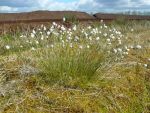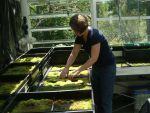TORFMOOS

Sphagnum as renewable resource: Establishment of Sphagnum – optimization of growing conditions.
The objective of this pilot project was to investigate whether artificially distributed Sphagnum mosses can be established on cut-over peat and what are the optimal growing conditions. Further aims included the search for additional areas of utilization of Sphagnum biomass apart from those already identified
Content and results
Greenhouse trials investigated the influence of abiotic site conditions on the growth of different Sphagnum species resulting in the identification of the water level as the main factor for vigorous growth (University of Greifswald, Agency of Lower Saxony for mining, energy and Geology).
A trial area was established on the cut-over peatland Esterweger Dose, near Ramsloh in Lower Saxony. Peat extraction for horticultural growing media is currently still taking place at the site. It was successfully demonstrated that the cultivation of Sphagnum can be achieved on cut-over peat sites (University of Greifswald, Torfwerk Moorkultur Ramsloh Werner Koch GmbH & Co. KG, Agency of Agency of Lower Saxony for mining, energy and Geology in Bremen). After an initial establishment phase of 3 years a dense Sphagnum lawn was formed which produces now an average of 3 metric tons of dry biomass per hectare per year.
Additionally, the potential for regeneration of different Sphagnum species was investigated in greenhouse trials, in order to assess methods for the mass-production of diaspores (University of Greifswald). The results showed that smaller Sphagnum fragments yielded more but smaller and more delicate Sphagnum plants opposite to larger fragments yielding fewer but larger and more robust plants. Further it was demonstrated that Sphagnum biomass has the desired chemical properties to serve as ingredient in growing media used for the cultivation of ornamental plants and vegetables (Institute for Horticultural Teaching and Research in Hannover).
Further research
- Expansion of potential cultivation areas on peat (e.g. on former grasslands on degraded raised bog peat) MOOSGRÜN
- One of the main challenges on peat soil is the maintenance of well-balanced water levels. Alternatively, the cultivation of Sphagnum on floating rafts offers an optimal water supply for the plants at all times à projects MOOSFARM, PROSUGA
- Development of production methods for diaspores à PROSUGA, MOOSGRÜN
- The suitability of Sphagnum biomass as growing medium requires tests for further applications and new growing media should be developed à projects MOOSFARM, PROSUGA, MOOSGRÜN













